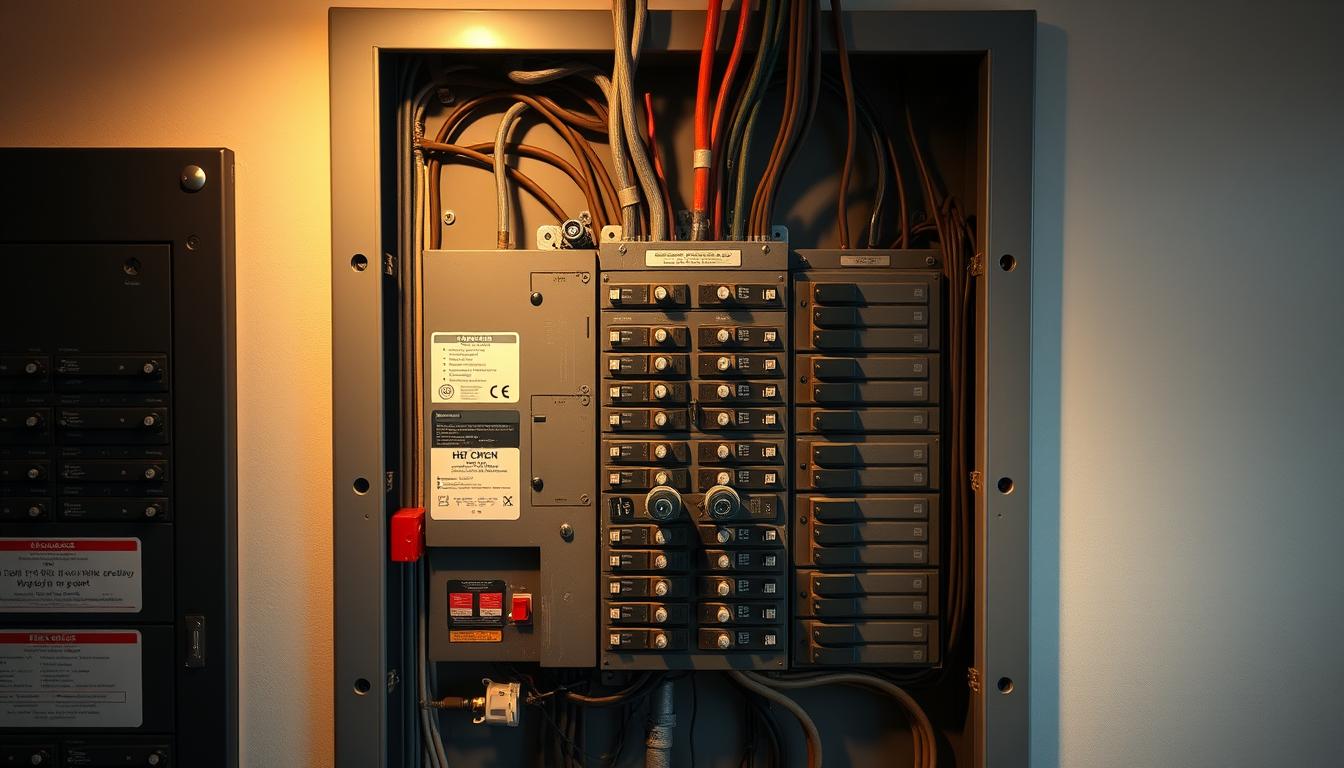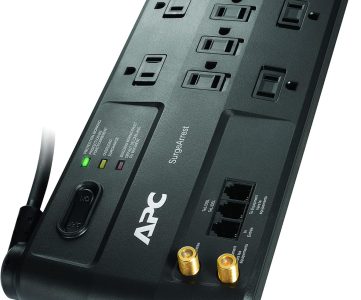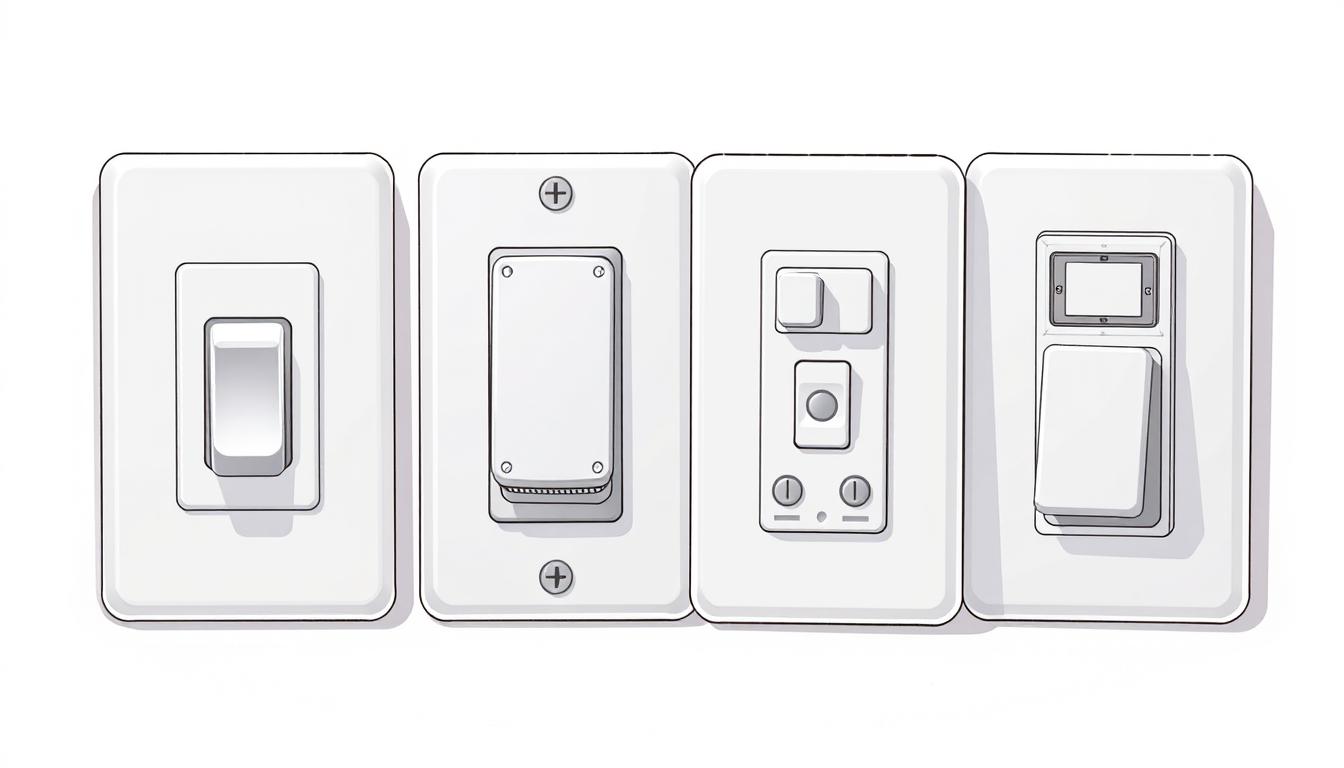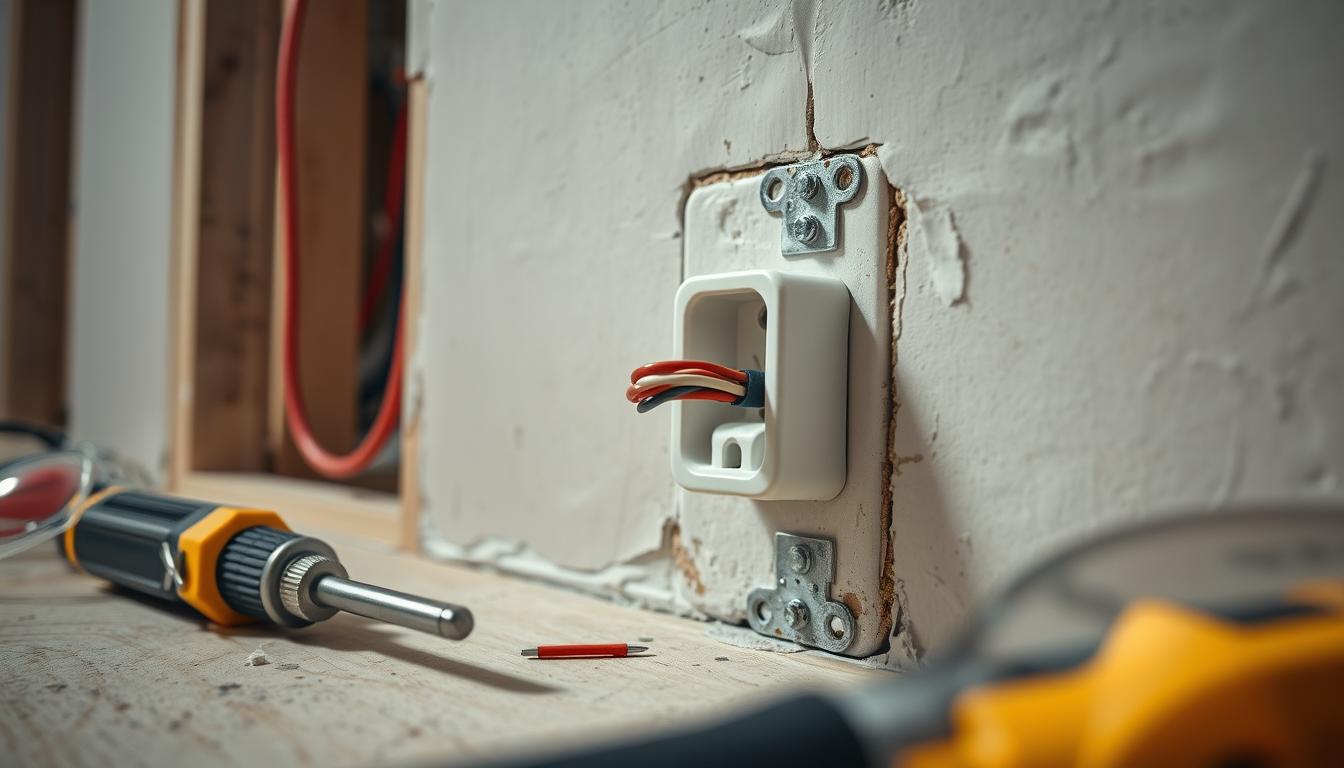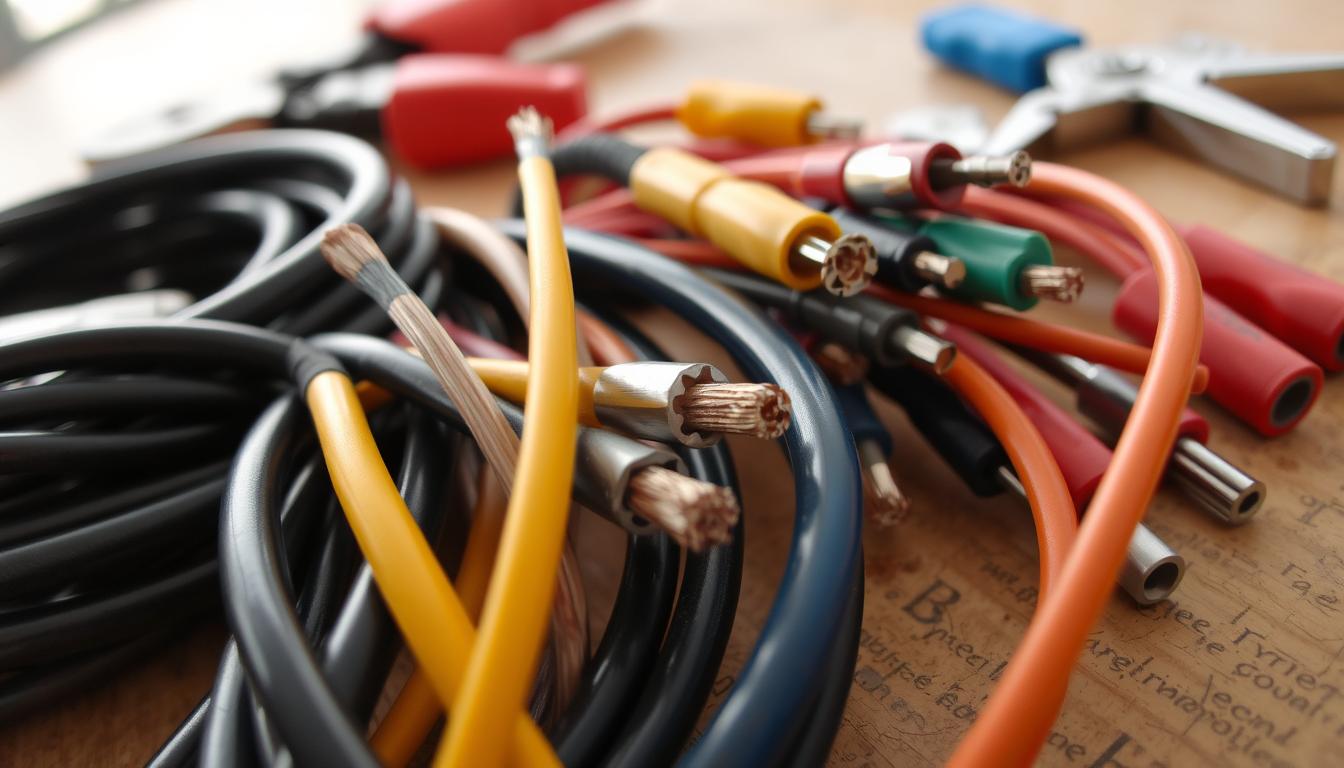A circuit breaker panel, also known as an electrical panel, is the heart of a home’s electrical system. It controls and regulates electricity to different parts of the house. The panel has circuit breakers that protect the electrical system from damage.
The electrical panel is key to a home’s electrical safety and efficiency. Keeping it well-maintained can prevent electrical fires. It ensures the electrical system works right.
Knowing about the breaker panel and its parts helps homeowners spot problems early. Regular upkeep of the electrical panel can also make it last longer. This saves money on expensive repairs.
Key Takeaways
- The circuit breaker panel is the main electrical distribution point in a home.
- Regular maintenance of the electrical panel is essential for ensuring electrical safety and efficiency.
- Circuit breakers protect the home’s electrical system from damage.
- A well-maintained breaker panel can help prevent electrical fires.
- Understanding the breaker panel and its components can help homeowners identify potential issues.
What Is a Circuit Breaker Panel?
A circuit breaker panel, also known as a breaker box or electrical panel, is key to a home’s electrical system. It ensures electrical safety by controlling the electricity flow to different parts of the house. The panel layout helps connect and manage electrical components safely and efficiently.
The main breaker, circuit breakers, and panel board are at the heart of the electrical panel. The main breaker manages the house’s power supply. Circuit breakers control the electricity to each circuit. Knowing about main breaker panels, subpanels, and load centers is vital for electrical safety and efficiency.
Main Components of a Breaker Panel
- Main breaker
- Circuit breakers
- Panel board
The panel layout is also crucial for the electrical system’s proper function. A well-designed layout can prevent electrical hazards and ensure efficient operation. By understanding load centers and other components, homeowners can keep their electrical system safe and reliable.
Understanding Your Home’s Electrical Distribution System
It’s key to know how power is distributed in your home. This system makes sure power is safe and efficient. It uses wires, circuit breakers, and panels to control electricity flow.
Circuit breakers turn off power if there’s too much or a short circuit. Electrical panels send power to different areas of the house. Proper installation and maintenance of these parts are vital for safety.
Good electrical systems offer many benefits. They include:
- Efficient power distribution
- Enhanced electrical safety
- Reduced risk of electrical fires
- Improved overall performance of electrical devices
Knowing how your electrical system works helps spot problems. Regular checks and updates to panels and breakers are important. A safe system protects your home and family.
When it comes to power, think about your home’s needs. Make sure your panel and breakers can handle all your devices. Taking care of electrical safety means a safer, more comfortable home.
Essential Safety Features of Modern Breaker Panels
Modern breaker panels have many safety features to protect homeowners. These features help prevent electrical shock and other dangers. A well-organized panel is key to avoiding accidents. It makes sure all parts are easy to find and use, lowering the risk of shock or fire.
Important safety features include ground fault circuit interrupters (GFCIs) and arc fault circuit interrupters (AFCIs). These devices spot ground faults and arc faults and cut off power. Main disconnect features also let you safely turn off power to the whole house in emergencies. This ensures safety and keeps the panel organized.
It’s crucial to know about these safety features and how they work. By focusing on electrical safety and panel organization, homeowners can feel safe and protected. Here are some important safety features to look for in a modern breaker panel:
- Ground Fault Circuit Interrupters (GFCIs)
- Arc Fault Circuit Interrupters (AFCIs)
- Main Disconnect Features
Choosing a modern breaker panel with these features ensures safety and organization. This makes your home a safe and secure place to live.
| Safety Feature | Description |
|---|---|
| Ground Fault Circuit Interrupters (GFCIs) | Detect ground faults and interrupt the electrical circuit |
| Arc Fault Circuit Interrupters (AFCIs) | Detect arc faults and interrupt the electrical circuit |
| Main Disconnect Features | Provide a safe and convenient way to shut off power to the entire house |
Common Signs of Breaker Panel Problems
Spotting issues with your electrical panel is key to keeping your home safe and running well. A common sign is flickering lights, which might mean a bad circuit or too much load on the panel. Also, a warm or burning smell from the panel is a fire risk and needs quick action.
Other signs include circuit breakers that trip often, which could mean too much load or a broken breaker. Knowing how your circuit breakers function and spotting problems early is crucial.
- Flickering lights
- Warm or burning smells
- Circuit breakers that trip frequently
Being alert to these signs and acting fast can keep your home’s electrical system safe and efficient. This helps avoid dangers from a faulty electrical panel.
How to Read Your Panel’s Circuit Directory
Knowing your home’s electrical system is key for safety and efficiency. The circuit directory, found on the panel layout, shows your home’s electrical circuits. It lists each circuit breaker and its amperage rating.
To understand your panel’s circuit directory, look for the main parts. These are the circuit breakers and their amperage ratings. Knowing this helps prevent overloading, which can be dangerous and damage equipment.
Mapping Your Home’s Circuits
Mapping your home’s circuits means identifying each area and its power source. Check your circuit directory for labels or markings. They show which circuits power areas like the kitchen or bedroom.
Understanding Amperage Ratings
Amperage ratings are vital for a safe electrical system. A higher rating means a circuit can handle more power. A lower rating is for lighter loads. Knowing this is crucial for safely adding new appliances or making repairs.
Circuit Identification Best Practices
Following circuit identification best practices is important. Label circuits clearly and use color-coded labels for different types. Keep your circuit directory updated. These steps help avoid confusion and ensure your electrical system works well.
When to Schedule Professional Panel Inspections
Keeping your home safe from electrical dangers is key. One important step is to get regular checks on your electrical panel. These checks can spot problems early, keeping you and your family safe.
Look out for signs like flickering lights, burning smells, or warm outlets. If you’re selling your home or just bought a new one, an inspection is a smart move. It tells you about your electrical system’s health.
Professional inspections boost electrical safety, make your system more efficient, and extend its life. Catching issues early saves you from expensive fixes and keeps your electrical panel running right.
Here are some reasons to get a professional inspection:
- Old electrical panels might not be safe anymore.
- Changes in your home’s electrical setup can impact safety and efficiency.
- If you’re worried about your home’s electrical safety, an expert check can ease your mind.
Upgrading Your Electrical Panel: Signs It’s Time
As homes get older, their electrical panels can become outdated. This can lead to safety risks and inefficiencies. Upgrading your electrical panel, including load centers, is key for safety and efficiency. Your home’s electrical panel is its heart, and it must handle more power as needed.
There are clear signs it’s time to upgrade your electrical panel. These include:
- Age-related concerns: Electrical panels last about 20-30 years before needing a replacement.
- Capacity requirements: New appliances or home additions might need a panel that can handle more power.
- Modern safety standards: Old panels might not meet today’s safety standards, like AFCIs and GFCIs.
Upgrading to a modern electrical panel brings many benefits. It improves safety, boosts efficiency, and increases your home’s value. Always talk to a licensed electrician to find the right upgrade for your home’s electrical system.
Maintaining Your Circuit Breaker Panel
Keeping your circuit breaker panel in good shape is key for electrical safety and efficiency. A tidy panel looks better and makes it easier to spot problems. To keep your panel organized, label each breaker and keep it clean and dry.
Here are some tips to maintain your circuit breaker panel:
- Regularly check the panel for wear and tear
- Keep the panel clean and dry to avoid moisture damage
- Make sure all circuit breakers work right
By following these easy steps, you can keep your circuit breaker panel safe and efficient. This ensures electrical safety and peace of mind. A well-kept panel is vital for your home’s electrical system.
If you’re not sure about maintaining your circuit breaker panel, talk to a licensed electrician. They can offer expert advice and make sure your panel is safe and working well.
| Maintenance Task | Frequency |
|---|---|
| Inspect the panel | Every 6 months |
| Clean the panel | Every 3 months |
| Check circuit breakers | Every 12 months |
Emergency Procedures and Safety Protocols
In case of an electrical emergency, having a plan is key. It ensures electrical safety and reduces damage. Knowing how to handle power outages and fires is important. Also, knowing when to call an electrician is crucial.
A well-kept circuit breaker panel helps avoid emergencies. Regular checks can spot issues early, preventing big problems.
Power Outage Response
When there’s a power outage, safety comes first. Stay away from downed power lines. Also, don’t use generators inside.
Fire Safety Measures
Fires are a big risk in electrical emergencies. Working smoke detectors and a fire extinguisher are vital. They help stop fires from getting worse.
When to Call an Electrician
If you’re not sure what to do in an electrical emergency, it’s safer to call a licensed electrician. They can check the situation and guide you on what to do next.
By following these steps, you can keep your home and family safe in electrical emergencies. Always put electrical safety first. Take steps to prevent emergencies before they happen.
| Emergency Situation | Response |
|---|---|
| Power Outage | Avoid downed power lines, do not use generators indoors |
| Fire | Use fire extinguisher, evacuate the area |
| Electrical Shock | Turn off power source, call emergency services |
Smart Panel Technologies and Future Innovations
The future of electrical panels is getting smarter, focusing on power distribution and efficiency. Home automation systems are now linked with the electrical panel. This makes controlling and monitoring a home’s electrical systems easy.
Smart panel technologies offer many benefits, including:
- Improved electrical safety with real-time monitoring and alerts
- Increased energy efficiency through better power distribution
- Higher home value with smart technology integration
Energy monitoring systems are key in smart panels. They give homeowners detailed energy usage insights. This helps them make better energy choices. As smart panel tech advances, we’ll see more innovative ways to manage electrical panel and power distribution.
| Technology | Benefits |
|---|---|
| Home Automation Integration | Improved control and monitoring of electrical systems |
| Energy Monitoring Systems | Real-time energy usage insights and optimized power distribution |
Legal Requirements and Building Codes
Electrical safety is key, and following legal rules and building codes is essential. The National Electric Code (NEC) is the standard for electrical panel setups. It ensures electrical safety and efficiency. Homeowners need to know the NEC and local laws to avoid fines or penalties.
Understanding the NEC and local codes is crucial. Key points include:
- Panel size and capacity
- Circuit requirements and wiring
- Grounding and bonding
- Inspection and testing procedures
Following these rules helps homeowners ensure their electrical panel is safe. It’s also wise to check with a licensed electrician for local rules.
Keeping up with new rules and codes is important for electrical safety. The NEC changes every three years. Homeowners should know about these updates. By focusing on electrical safety, homeowners can keep their homes safe for everyone.
A well-kept electrical panel is vital for home electrical safety. By following laws and codes, homeowners can have peace of mind and a safe home.
| Code Requirement | Description |
|---|---|
| NEC 210.12 | Requires grounding and bonding for electrical panels |
| NEC 220.12 | Specifies load calculations for electrical panels |
| Local Ordinance | May require additional inspections or permits |
Conclusion: Ensuring Your Home’s Electrical Safety and Efficiency
Keeping your circuit breaker panel in good shape is key for your home’s electrical safety and efficiency. This guide has given you tips to make sure your electrical panel works well and is safe. It meets today’s safety standards.
This article has helped you understand your breaker panel better. You now know how to spot problems early. It’s important to get regular checks, update your panel when needed, and always be careful with electrical issues.
By looking after your circuit breaker panel, you’ll feel safer and more comfortable at home. Explore smart panel tech and keep up with new ideas to improve your home’s electrical setup. Your home’s electrical health is vital for comfort and safety. Don’t overlook it.
